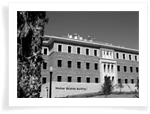Historical Archive
A glimpse at where it all began...
Articles and Press Releases
Speeches and Welcomes
From a vision to a school, a roadmap of historical events
In 1999, then Texas Tech System Chancellor John T. Montford shared with the Board of Regents a vision for a full-fledged four-year medical school in El Paso. A four-year medical school in El Paso could help alleviate a severe shortage of physicians in the area. Currently, there are less than 110 physicians for every 100,000 people in El Paso. The national average is 198 physicians per 100,000 population. The Texas average is only 150 per 100,000. Studies have shown that most medical students remain in the region in which they received their education to establish their practices. The addition of the first two years of the medical school will allow students from El Paso and nearby regions to complete their education near home. It is hoped this effort will help retain doctors in the area.
During the 2001 Texas Legislative Session, the El Paso legislative delegation successfully spearheaded an effort to secure $40 million in tuition revenue bonds for the research facility, one of three buildings on the new campus, just a short walk from the Texas Tech University Health Sciences Center-as well as an $11 million clinic expansion project that took about two years, and added a third floor on the present Texas Tech Medical Center building. During the expansion and renovation, the clinics still saw over 300,000 patient visits!
Longtime community philanthropists J.O. and Marlene Stewart donated 10.2 acres of land near the HSC for the new medical campus. The Paso del Norte Foundation approved a $1.25 million scholarship grant program for local students contingent on the approval of the four-year medical school. Over the past several years, generous El Pasoans and other local businesses have stepped forward to contribute to what is now called the Infinity Campaign.
Governor Rick Perry visited the El Paso campus for a ceremonial signing of House Bill 28, Article 10, which authorized Texas Tech to proceed. He simultaneously announced an additional $2 million more in funding to finance start-up costs and faculty salaries.
On December 9, 2003, the ground breaking for El Paso Medical Science Building I took place and two years later, January 31, 2006, a ribbon cutting followed. The 93,000 square-foot facility will house research on diabetes, cancer, environmental health, and infectious diseases, as well as a repository dedicated to data on Hispanic health and a genomic facility to link hereditary diseases in families. With the Hispanic population increasing throughout the United States, El Paso has become the new face of the nation. Understanding Hispanic and Border health issues will help scientists better understand the nation as a whole. Biomedical research conducted in El Paso will take on enormous importance and form the base of knowledge our country needs, for today and tomorrow.
In December of 2005, a ground breaking was held for the medical classroom building. The 125,000 square-foot building has four floors and a partial penthouse. Included in the plans are classrooms, a library, small group rooms, a clinical skills area for students, faculty and administrative areas, basic sciences labs, a gross anatomy lab, a student services area, and food services.
Students graduating now from Texas Tech Health El Paso will have seen diseases that only a small fraction of medical students ever come across in their four years of medical school. El Paso students may encounter biblical diseases such as plague, and other ailments that have virtually been wiped out in the United States, but flourish in many emerging nations. The volume of patients our students see is greater than at other campuses and it provides an intense learning environment, allowing our future doctors to learn so much more than classic "text book" cases.




